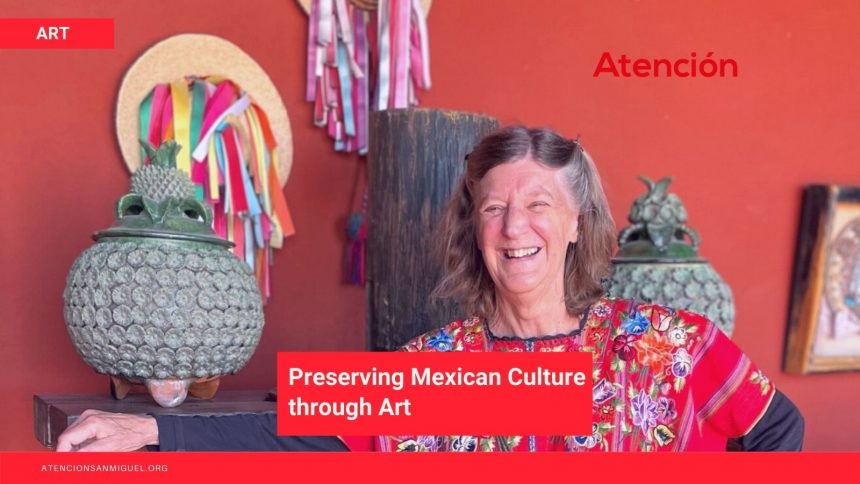Zoom Presentation
Mujeres en Cambio presents
“Preserving Mexican Culture through Art”
Virtual visit and talk By Heidi LeVasseur
Wed, Mar 31, 1pm
US$15 (300 pesos)
Payable at: www.mujeresencambio.org
By Natalie Taylor
Walk into Heidi LeVasseur’s house, and you immediately realize this is not going to be an ordinary experience. You scramble up a darkly lit staircase flanked by illuminated niches, holding brilliantly colored masks; the tunnel-like space is reminiscent of an ancient castle filled with secrets. Then the space opens up, and you’re in a bright living area filled with native art. The house is a little bit of this, a touch of that, a lot of the other. This is Heidi and Bill’s home, but there is much more. It’s a B&B called Casa de la Cuesta, a studio where Heidi does clay work, an extensive Mexican mask museum run by Bill, and an art gallery and shop with beautiful works produced by artists and craftsmen from all over the country.
Heidi herself is like her house—a bit of this, a touch of that, a lot of the other. She is an artist who creates her own distinctive pieces, but she’s also a promoter of Mexican arts and crafts. She is a collector who has spent years bringing unique pieces to her gallery, which she displays on the walls, on furniture, and even on the floor. Heidi is also a hostess who runs a bed and breakfast. And she is a wonderful raconteur who effortlessly weaves tales and history into a cohesive story of Indigenous culture all over Mexico. Heidi and Bill are originally from New York, then spent several years living in Mexico City, where she was involved in art and culture. In 1999 they came to live in San Miguel de Allende.
As you first enter the gallery, Heidi herself will tell you that it’s a hodgepodge. Indeed, it’s an overwhelming feast for the eyes. Within this fairly small space, she attempts to show and preserve the different cultures of Mexico through their art. There are gourds encrusted with beads done by the Huichols from Nayarit—a people who rejected the Conquistadors’ efforts to convert them to Catholicism. They continue to worship the god of Peyote, who they represent in their art. On the walls hang blouses with big, bright flowers (such as Frida Kahlo liked to wear). These are typical of the Zapotecs from Oaxaca, who acquired and learned how to work with silk by trading with Chinese sailors in the 16th century and later. There are Otomi, amate paper wall-hangings, with elaborate engravings or cutouts.
This is only a sample of what’s in the gallery. But it’s consistent with Heidi’s vision and premise—all Mexican art has a story. Each region specializes in a particular technique, uses certain materials, portrays what is distinct to them. It is one Mexico, but it’s a conglomerate of many cultures. In Heidi’s Gallery you can find them represented through art. Mujeres en Cambio invites you to join her on Zoom as she tells her stories on March 31 at 1pm. Cost is US$15 (300 pesos): www.mujeresencambio.org.

